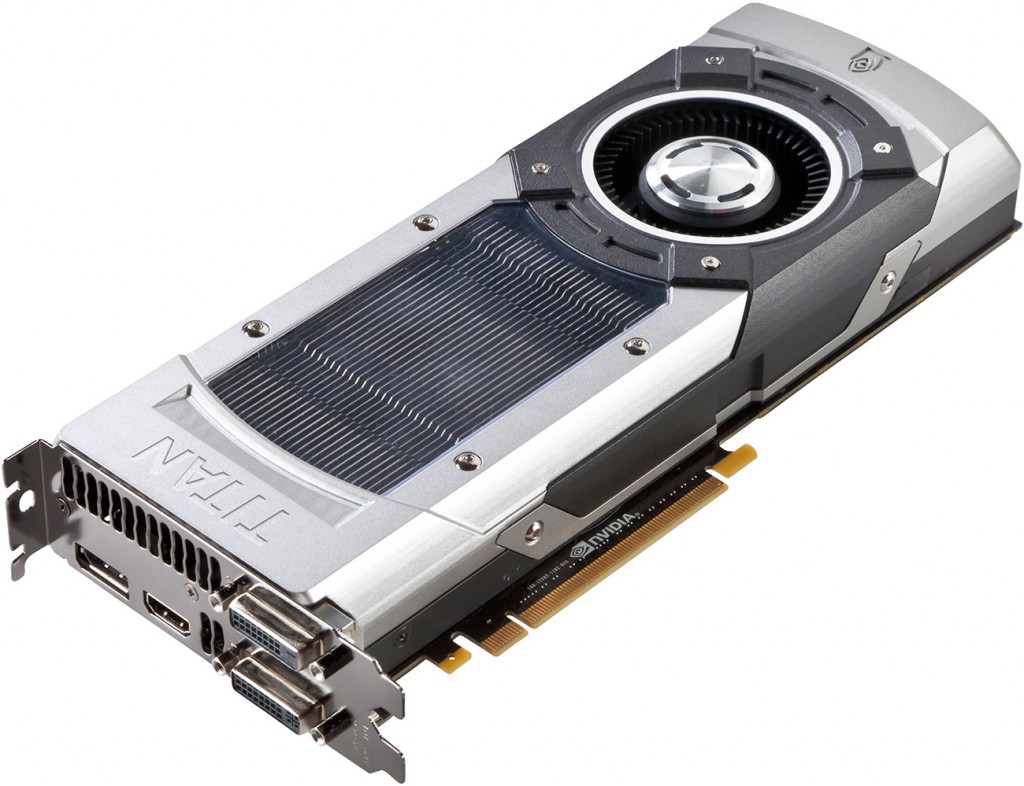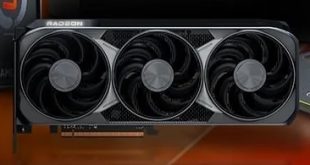It is not a secret that Nvidia Corp. is working on new ultra-high-end graphics cards based on the code-named GM200 graphics processing unit (GPU). But is it worth waiting for a new top-of-the-range graphics board from Nvidia, or it makes sence to get a GeForce GTX 980 now? Apparently, the new GTX Titan will be significantly faster than the current high-end graphics solution.
Nvidia is working on two graphics cards based on the GM200 graphics processing unit: one will feature fully-fledged GM200 GPU, whereas another will sport a cut-down version with 2688 stream processors (and 21 streaming multiprocessor modules), reports Chiphell web-site. The maximum configuration of GM200 is unknown, but a natural guess would be 3072 stream processors and 24 compute modules.
According to performance estimates posted by Chiphell web-site, the new top-of-the-range GeForce GTX Titan graphics board from Nvidia will be 34 per cent faster than the GeForce GTX 980 graphics card.
Given the fact that the amount of stream processors inside GM200 is around 1/3 times higher than the number of SPs inside GM204, it is logical to assume that the graphics solution is around 33 per cent faster.
While 33 – 34 per cent performance difference may not be significant when it comes to high-end graphics solutions as they all offer enough performance for almost any game, if you plan to play in ultra-high-definition resolution in demanding titles, you are going to need every bit of performance you can get. Therefore, if money is not a problem, it makes a lot of sense to wait for Nvidia’s next-generation Titan to arrive.
Nvidia did not comment on the news-story.
Discuss on our Facebook page, HERE.
KitGuru Says: While it is clear that Nvidia is working on a new GeForce GTX Titan-like graphics board, it will be very interesting to learn whether the company also intends to release a new dual-chip flagship product. Energy-efficiency of Maxwell should allow to build it with high frequencies, which will make it much more competitive than the GeForce GTX Titan Z was earlier this year.
 KitGuru KitGuru.net – Tech News | Hardware News | Hardware Reviews | IOS | Mobile | Gaming | Graphics Cards
KitGuru KitGuru.net – Tech News | Hardware News | Hardware Reviews | IOS | Mobile | Gaming | Graphics Cards



34% faster and better but I’m sure it’s at least 50% costlier than the latter…
So long as these have 6Gb of ram that will be fine
and a 384 bit bus 🙂
6 GB VRAM, 384-bit bus, ~30% more power at stock speeds. Sounds good enough for me.
UM 3072/2048 =1.5
and the Bermuda XT is 65% faster than the 290x. I’m more excited about the AMD Bermuda XT “390X” than the GTX 980ti.. I will still own both though:p
I will be with 970 until you release the MoNsTeR GpU TiTaN MaXwELL. I dont need a cut down version – there is no compromise on 4K. Sorry AMD but until you do not release FreeSync, I will not buy any of ur cards.
Ya, so it’s 33% more or a 50% increase. Genius.
Well, I have the GTX 980 Classified… $700… If it comes out what price do you guys think the new Titan will be? If it’s like $1,500 it won’t be worth trading in my card for it…
here you go 🙂
http://www.guru3d.com/news-story/amd-fijixt-bermuda-xt-makes-mystery-appearance.html
Pssssht. Just pick up a couple of 970’s. 50% greater performance for a mere 20% more cost.
“Percent more” and “percent increase” say the same thing. If the GTX 980 has 2048 stream processors and the GM200 has 3072 stream processors, then the GM200 has (3072-2048)*100/2048 = 50% more stream processors then the GTX 980. Therefore it should be 50% faster, if the same clock speed is used.
Maybe the confusion is that 2048 is 2/3 of 3072. So that the extra 1024 stream processors make up 33% of the totality of GM200’s 3072 stream processors. But that is not what it means to be “percent more” or “percent increase”. Defining it that way would make it harder to directly compare the relative increase of two different things relative to a third.
Consider the following: 10, 15, 20. The absolute increase of 20 over 10 is 10, twice the absolute increase of 15 over 10, which is 5. Using the definition I used in the first paragraph, 15 is 50% more than 10 and 20 is 100% more than 10. 100% is twice 50%, so the ratio is preserved. If we were to use the definition in paragraph two, which was my best guess of how one might arrive at “33% more” being correct for the article, then 15-10=5 and 5 is 33% of 15, so 15 would be 33% more than 10, and 20-10=10, 10 is 50% of 20, so 20 would be 50% more than 10. Now you see that comparing the 33% more to the 50% more is not straightforward. It no longer scales linearly. Additionally, one could only approach, but never equal or exceed “100% more” under this definition.
After going 680>780Ti, 34% seems rather disappointing….
This what “Big daddy” Maxwell is not getting as much of a boost as “Big Daddy” Kepler?
At this point I’d probually skip it & wait for Pascal. Really not enough of a jump.
but they are comparing to a known card
the corrent statement would be the GM204 is 33% slower than a GM200
aka the 200 is 50% faster than the 204
i personally find %more/less/off and times faster (as fast as, etc) to be rather ugly
i prefer whole multipliers/percents (eg 1.5x or 150% peformance of etc)
like extra 20%off (for a 70%off sale)
thinks: 70+20=90%off
reality: (100-30%*.8)=76%off
should’ve said only 80% at checkout or something
I was replying to Hoss delux. Not sure why you are replying to me, but there’s nothing ugly about relative change. When dealing with change of percentages, one needs to indicate whether one means relative or absolute change. Otherwise, it’s ambiguous. Your example store is being purposefully ambiguous. There was no ambiguity in the article, it was just stated incorrectly. If you believe that the problem arose because the author was calculating that GM204 is 33% slower than GM200, he could just have easily taken 2048/3072 and got .67 instead of 1.5. You might be thinking that he knows GM200 should be faster and should realize something is wrong if he gets a number less than 1, but he similarly should be getting a negative relative percent for the “33% slower” calculation if he takes similar care.
Yeah whatever. AMD always talks a big game and then it’s actually released and it’s shit.
Yeah whatever. AMD always talks a big game and then it’s actually released and it’s shit.
No won’t “Juan” now go get me some oranges.
yeah the 33% should be a 50
well the problem is sometimes people mix it up
It’s possibly downclocked out of the box… it only gets a 50% boost if it’s running at the same clock speed as the 980.
Ofcourse you can probually increase the clock speed back up with overclocking & then even exceed it.
unlikely the clocks arent that high
I agree actually for the first time im more excited for 390x. The roumers sound crazy if true. Price is still problem with amd though.
facepalm* No graphics or CPU architecture scales 100%. The perfect scaling in fact follows Amdahl’s law.
They can’t fit anything bigger on the die while staying within the 600m2 limit. GM204 is almost 400mm2 and a 50% increase means almost 600mm2. They won’t be able to make anything more powerful than that without moving to a smaller node.
So, does that mean you’ll instantly buy one of their cards in 3-4 months when Freesync is more commonly available?
We are not refuting the article’s analysis, but rather the article’s mathematics. The article says: “Given the fact that the amount of stream processors inside GM200 is
around 1/3 times higher than the number of SPs inside GM204, it is
logical to assume that the graphics solution is around 33 per cent
faster.”
The analysis was 1/3 more SP means 1/3 more performance. But there are actually 1/2 more SPs in the GM200 compared to the GM204. So before you *facepalm, make sure you know what you are replying to, or just don’t *facepalm at all.
Furthermore, graphics is very highly parallel. Looking at a chart on Wikipedia, for a task which is considered “95% parallel,” one would expect very little benefit when increasing from 1024 to 2048 cores. However experience with graphics tells us this is not the case. Not only do the extra cores scale well to allow frames per second to be increased with one particular set of resolution and quality settings, they also allow an increase in resolution and quality settings. This is a changing of the problem, which is not covered by Amdahl’s Law, so that the most interesting comparisons between GPUs where one has less than double the amount of cores than the other might very well be kept in a linear or near-linear zone. In other words, almost no one cares that a 2048-core GM204 and a 3072-core GM200 both score about 180 frames per second (or what have you) in Doom 2. The problem can be made more complex so that the extra cores scale very nicely and the other parts of the architecture (memory, output, etc) are not the limiting factors.
Still thinking about 2x GTX 970 graphics cards and forgetting about all theses baby step story’s were hearing about TSMC, it’s been over two years and we’re still on 28nm.
PhoneyVirus
https://twitter.com/PhoneyVirus
https://phoneyvirus.wordpress.com/
A 512-bit bus would be much better.